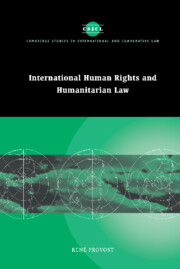Book contents
- Frontmatter
- Contents
- Acknowledgments
- Table of cases
- Table of treaties
- Table of other international instruments
- Introduction
- PART I Normative frameworks
- Introduction
- 1 Rights and procedural capacity
- 2 Obligations and responsibility
- Conclusion to Part I
- PART II Reciprocity
- PART III Application: law and facts
- General conclusion
- Bibliography
- Index
- CAMBRIDGE STUDIES IN INTERNATIONAL AND COMPARATIVE LAW
Conclusion to Part I
Published online by Cambridge University Press: 07 September 2009
- Frontmatter
- Contents
- Acknowledgments
- Table of cases
- Table of treaties
- Table of other international instruments
- Introduction
- PART I Normative frameworks
- Introduction
- 1 Rights and procedural capacity
- 2 Obligations and responsibility
- Conclusion to Part I
- PART II Reciprocity
- PART III Application: law and facts
- General conclusion
- Bibliography
- Index
- CAMBRIDGE STUDIES IN INTERNATIONAL AND COMPARATIVE LAW
Summary
The ultimate aims of human rights and humanitarian law may be the protection of the individual, but they are constructed to achieve this goal in significantly different ways. An analysis of the normative frameworks of these two legal systems reveals that each is fundamentally shaped by the place occupied by the individual. In human rights law, the individual is directly given fundamental rights by treaties and customary law, whereas in humanitarian law it is obligations which are imposed on the individual directly by conventional and customary law. Attempts to read individual obligations into the framework of human rights and see rights in humanitarian law norms are unconvincing because they are at odds with the basic thrust of each system. The differences in procedural capacity and responsibility are simply the consequences flowing from the initial emphasis on rights and obligations in human rights and humanitarian law.
The choice of a different nucleus in the two legal systems studied here is not coincidental nor the result of arbitrariness. It is the mirror of the vastly different realities which human rights and humanitarian law norms seek to address. In the context of a relationship between a state and private persons taking place in normal socio-economic conditions, it seems eminently suitable to entrust into the hands of individuals the tools which will enable them to defend the fundamental rights and freedoms necessary for their full development. An array of mechanisms is available to the individual, including judicial proceedings, the media, the political process, etc.
- Type
- Chapter
- Information
- International Human Rights and Humanitarian Law , pp. 116 - 118Publisher: Cambridge University PressPrint publication year: 2002

